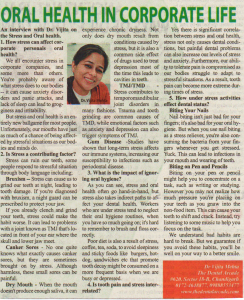Category Archives: Uncategorized
DRY MOUTH
Dry mouth (Xerostomia) results from an inadequate flow of saliva. It is not a disease, but a symptom of a medical disorder or a side effect of certain medications, such as antihistamines, decongestants, pain killers, diuretics and many others. Saliva is the mouth’s primary defense against tooth decay and maintains the health of the soft and hard tissues in the mouth.Saliva washes away food and other debris, neutralizes acids produced by bacteri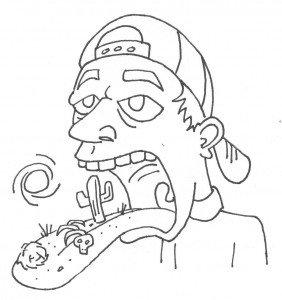 a in the mouth and provides disease-fighting substances throughout the mouth, offering first-line protection against microbial invasion that might lead to disease. Some of the common problems associated with dry mouth include a constant sore throat, burning sensation, trouble speaking and difficulty swallowing. Without saliva, extensive tooth decay can also occur. Your dentist can recommend various methods to restore moisture and give you relief.
a in the mouth and provides disease-fighting substances throughout the mouth, offering first-line protection against microbial invasion that might lead to disease. Some of the common problems associated with dry mouth include a constant sore throat, burning sensation, trouble speaking and difficulty swallowing. Without saliva, extensive tooth decay can also occur. Your dentist can recommend various methods to restore moisture and give you relief.
Teething
Although newborns usually have no visible teeth, most start developing baby teeth between 4-7 months of age. Children usually have their full set of 20 primary teeth in place by age 3. As their teeth erupt, some babies may become fussy, sleepless and irritable, lose their appetite or drool more than usual. But diarrhoea, rashes and a fever are not normal for a teething baby. Your child may have sore or tender gums when teeth begin to erupt. Gently rubbing their gums with a clean finger, a small cool spoon,or a moist gauze pad can be soothing. Your doctor may recommend a pacifier. When your child’s teeth begin to come in, brush them gently with a child’s size toothbrush and water. For children between the ages of 2 and 6, brush their teeth with a pea-sized amount of fluoride toothpaste. Be sure they spit out the toothpaste. You should start regular dental check-ups for your child after their first tooth appears, but no later than their first birthday.
clean finger, a small cool spoon,or a moist gauze pad can be soothing. Your doctor may recommend a pacifier. When your child’s teeth begin to come in, brush them gently with a child’s size toothbrush and water. For children between the ages of 2 and 6, brush their teeth with a pea-sized amount of fluoride toothpaste. Be sure they spit out the toothpaste. You should start regular dental check-ups for your child after their first tooth appears, but no later than their first birthday.
Tooth Mamelons
When your child’s permanent central teeth erupt, you may notice, on the top of the teeth, the incisal/biting edges, has bumps. These bumps are called tooth mamelons. Tooth mamelons vary from patient to patient. Some are very prominent and some look like the too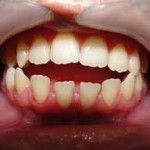 th has an indentation.The edges are rough and make the teeth look uneven. Mamelons are usually seen on the upper and lower, permanent central and lateral incisors. Some parents may be concerned when they see the permanent teeth because they think the tooth is damaged. However, such teeth should not be a cause for concern at all as it is a normal phenomenon. These are not seen in adults as these mamelons wear away with use.
th has an indentation.The edges are rough and make the teeth look uneven. Mamelons are usually seen on the upper and lower, permanent central and lateral incisors. Some parents may be concerned when they see the permanent teeth because they think the tooth is damaged. However, such teeth should not be a cause for concern at all as it is a normal phenomenon. These are not seen in adults as these mamelons wear away with use.
Ugly Duckling Phase
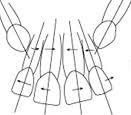 The ugly duckling stage, occurs during the mixed dentition phase (when both milk and permanent teeth are present in the mouth) of tooth eruption between the ages of 7-12 years. It is a stage of dental development that occurs during the eruption of the permanent canine, in which the lateral incisors become tilted because the erupting canines impinge on the roots of the incisors.
The ugly duckling stage, occurs during the mixed dentition phase (when both milk and permanent teeth are present in the mouth) of tooth eruption between the ages of 7-12 years. It is a stage of dental development that occurs during the eruption of the permanent canine, in which the lateral incisors become tilted because the erupting canines impinge on the roots of the incisors.  It is called ugly duckling stage because dentition in children at this stage looks very ugly due to multiple spacing between their teeth. This is a self-correcting condition and requires no treatment or cause for concern. However, check-ups at regular intervals is necessary to rule out the possibility of crowding and if crowding is suspected, growth modification appliances can be prescribed by the dentist.
It is called ugly duckling stage because dentition in children at this stage looks very ugly due to multiple spacing between their teeth. This is a self-correcting condition and requires no treatment or cause for concern. However, check-ups at regular intervals is necessary to rule out the possibility of crowding and if crowding is suspected, growth modification appliances can be prescribed by the dentist.
Diabetes and oral Health
Diabetes is a disease that can affect the whole body, including your mouth. Dental care is particularly important for people with diabetes because they face a higher than normal risk of oral health problems. This is because uncontrolled diabetes impairs white blood cells, which are the body’s main defense against bacterial infections that can occur in the mouth. People with diabetes face a higher risk of dry mouth, swelling of gums/periodontitis, poor healing of oral tissues or even burning mouth and/or tongue. People with diabetes who smoke are at even a higher risk — up to 20 times more likely than nonsmokers — for the development of periodontal disease. Smoking also seems to impair blood flow to the gums — which may affect wound healing in this tissue area. Thus meticulous oral hygiene and regular check-ups with the dentist is essential for people with diabetes.
Thumb-sucking
 Thumb-sucking is a natural reflex for children. Sucking on thumbs, fingers, pacifiers or other objects may make babies feel secure and happy and help them learn about their world. Young children may also suck to soothe themselves and help them fall asleep. However, after the permanent teeth come in, sucking may cause problems with the proper growth of the mouth and alignment of the teeth. Pacifiers can affect the teeth essentially the same ways as sucking fingers and thumbs, but it is often an easier habit to break.The intensity of the sucking is a factor that determines whether or not dental problems may result. Some aggressive thumb-suckers may develop problems with their baby teeth. Children usually stop sucking between the ages of two and four years old, or by the time the permanent front teeth are ready to erupt. If you notice changes in your child’s primary teeth, or are concerned about your child’s thumb-sucking, consult your dentist.
Thumb-sucking is a natural reflex for children. Sucking on thumbs, fingers, pacifiers or other objects may make babies feel secure and happy and help them learn about their world. Young children may also suck to soothe themselves and help them fall asleep. However, after the permanent teeth come in, sucking may cause problems with the proper growth of the mouth and alignment of the teeth. Pacifiers can affect the teeth essentially the same ways as sucking fingers and thumbs, but it is often an easier habit to break.The intensity of the sucking is a factor that determines whether or not dental problems may result. Some aggressive thumb-suckers may develop problems with their baby teeth. Children usually stop sucking between the ages of two and four years old, or by the time the permanent front teeth are ready to erupt. If you notice changes in your child’s primary teeth, or are concerned about your child’s thumb-sucking, consult your dentist.
DENTURES
Dentures are removable appliances that can replace missing teeth and help restore your smile. If you’ve lost all of your natural teeth, whether from gum disease, tooth decay or injury, replacing missing teeth will benefit your appearance and your health. When you lose all of your teeth, facial muscles can sag, making you look older. Dentures can help fill out the appearance of your face and profile. They can be made to closely resemble your natural teeth so that your appearance does not change much. New dentures may feel awkward for a few weeks until you become accustomed to them. 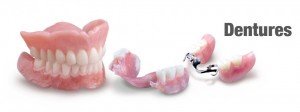 The dentures may feel loose while the muscles of your cheek and tongue learn to keep them in place. It is not unusual to experience minor irritation or soreness. You may find that saliva flow temporarily increases. As your mouth becomes accustomed to the dentures, these problems should go away. Follow-up appointments with the dentist are generally needed after a denture is inserted so the fit can be checked and adjusted. Even if you wear dentures, you still have to practice good dental hygiene. Brushing your gums, tongue and roof of your mouth every morning with a soft-bristled brush before wearing your dentures, stimulate circulation in your tissues and help remove plaque.
The dentures may feel loose while the muscles of your cheek and tongue learn to keep them in place. It is not unusual to experience minor irritation or soreness. You may find that saliva flow temporarily increases. As your mouth becomes accustomed to the dentures, these problems should go away. Follow-up appointments with the dentist are generally needed after a denture is inserted so the fit can be checked and adjusted. Even if you wear dentures, you still have to practice good dental hygiene. Brushing your gums, tongue and roof of your mouth every morning with a soft-bristled brush before wearing your dentures, stimulate circulation in your tissues and help remove plaque.
Bruxism
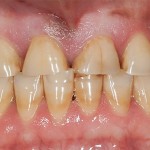 Bruxism is the excessive grinding of the teeth and/or excessive clenching of the jaw. It is an oral parafunctional activity, i.e., it is unrelated to normal function such as eating or talking. Bruxism is a common problem. There are two main types of bruxism: that which occurs during sleep (sleep bruxism) and that which occurs during wakefulness (awake bruxism). Dental damage may be similar in both types, but the symptoms of sleep bruxism tend to be worst on waking, and the symptoms of awake bruxism may not be present at all on waking, and then worsen over the day.The causes of bruxism are not completely understood, but probably involve multiple factors including stress. Bruxism may cause minimal symptoms, and therefore people may not be aware of the condition. Symptoms commonly associated with bruxism include hypersensitive teeth, aching jaw muscles, and headaches. Bruxism may cause tooth wear, and even damage or break teeth and dental restorations such as crowns and fillings. Treatment revolves around repairing the damage to teeth that has already occurred, and also night-guards to prevent further damage.
Bruxism is the excessive grinding of the teeth and/or excessive clenching of the jaw. It is an oral parafunctional activity, i.e., it is unrelated to normal function such as eating or talking. Bruxism is a common problem. There are two main types of bruxism: that which occurs during sleep (sleep bruxism) and that which occurs during wakefulness (awake bruxism). Dental damage may be similar in both types, but the symptoms of sleep bruxism tend to be worst on waking, and the symptoms of awake bruxism may not be present at all on waking, and then worsen over the day.The causes of bruxism are not completely understood, but probably involve multiple factors including stress. Bruxism may cause minimal symptoms, and therefore people may not be aware of the condition. Symptoms commonly associated with bruxism include hypersensitive teeth, aching jaw muscles, and headaches. Bruxism may cause tooth wear, and even damage or break teeth and dental restorations such as crowns and fillings. Treatment revolves around repairing the damage to teeth that has already occurred, and also night-guards to prevent further damage.
Baby Bottle Tooth Decay
Tooth decay in infants and toddlers is often referred to as Baby Bottle Tooth Decay, or Early Childhood Caries. Children need strong, healthy teeth to chew their food, speak and have a good-looking smile. Their first teeth also help make sure their adult teeth come in correctly. Baby Bottle Tooth Decay most often occurs in the upper front teeth, but other teeth may also be affected. Rarely, the lower front teeth are affected as the tongue acts a barrier while feeding. One common cause is the frequent, prolonged exposure of the baby’s teeth to drinks that contain sugar.Tooth decay can occur when the bab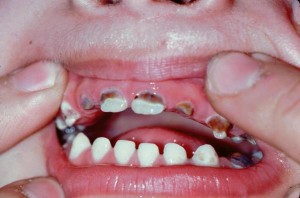 y is put to bed with a bottle, or when a bottle is used as a pacifier for a fussy baby. If your infant or toddler does not receive an adequate amount of fluoride, they may also have an increased risk for tooth decay. The good news is that decay is preventable by keeping a few things in mind. By consulting the dentist, he can guide you the right way. Proper cleaning of teeth after feeds, not feeding at bedtime or giving clean pacifiers not dipped in sugary fluids like honey all help prevent baby bottle decay.
y is put to bed with a bottle, or when a bottle is used as a pacifier for a fussy baby. If your infant or toddler does not receive an adequate amount of fluoride, they may also have an increased risk for tooth decay. The good news is that decay is preventable by keeping a few things in mind. By consulting the dentist, he can guide you the right way. Proper cleaning of teeth after feeds, not feeding at bedtime or giving clean pacifiers not dipped in sugary fluids like honey all help prevent baby bottle decay.

